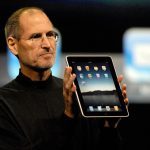
[By Greg Mahlknecht]
The elements of the future of the desktop are slowly falling into place. No one company has a comprehensive set of products and services that will deliver the future of computing, but the shape of things to come is getting clearer.
The key driver behind it all is convergence — convergence onto a single productivity device, and convergence in the “cloud”.
In hardware, desktops are losing market share to notebooks, which in turn are being eroded by netbooks, a market which itself is being diversified into tablets like the Apple iPad.
And devices like the BlackBerry and other smartphones have blurred the lines for the device of choice for a number of tasks such as e-mail and calendaring.
The iPad offers a great form factor for casual use. And it doesn’t take much to see how the much trumped and apparently now shelved Hewlett-Packard Slate could entirely replace a PC, especially when used in conjunction with a docking station.
In software, things are even more complex.
In operating systems, a three-way battle is emerging between Apple (with iOS used on the iPad and iPhone), Google’s Android, and the various flavours of Microsoft’s Windows.
And applications are shifting to the Web, or into the “cloud”, to use industry parlance.
Classic desktop applications like e-mail now use cloud-based storage. Full applications, such as Salesforce.com and Google Docs, are even offered online using the software as a service (Saas) model.
Then there’s the enabling technology that binds all this together. The two approaches here are Saas and the proprietary application store model, where apps are tied to the operating system and the data is stored on the Internet — in the cloud.
The guys who make operating systems — not to mention most users — love the idea of using native apps. Developers, on the other hand, love the idea of Saas.
Both camps will play a large part in the future of computing, but more non-core products and services will be based on Saas due to the enormous time involved in developing myriad native apps for multiple operating systems.
Once again, there are three main players in this game: Google, Apple and Microsoft. And they are all desperately trying to cover all the bases with varying degrees of success.
Google
The first company that springs to mind for cutting-edge, next-generation technology is Google. Ironically, this is the company struggling the most to carve a profitable niche into the future.
Hardware-wise, Google has nothing to offer. But their Android operating system is proving wildly successful.

In typical Google fashion, the company stormed out of the starting blocks with a mediocre product and improved it incrementally, but did so very quickly. This approach worked very well on the Web, but it has proven somewhat troublesome with Android, as we are left with a fragmented set of devices beyond Google’s direct control.
Microsoft’s Windows Mobile suffered from this fragmentation and it eventually became impractical to maintain. One hopes Google recognises this threat sooner rather than later.
Chrome OS, though still unreleased, is Google’s obvious play for the Saas market. It sees the operating system as a way to lock users into their ecosystem on cheap devices, most likely tablets.
Being just a glorified browser, they are banking on everyone doing everything online and optimising it to make the Google cloud-services experience better. This suits them just because instead of venturing out their online safety zone, they are trying to pull everyone into the place they consider themselves king.
But therein lies the problem for Google. Though it has a rich set of cloud apps — Gmail, Google Docs, Maps — none is really good enough to replace its desktop counterpart. Sure, Gmail is a great Web app, but it falls woefully short when compared to the native mail readers on devices such as the BlackBerry, the iPhone and the iPad. And this generally holds true for just about any Saas application.
Apple
At the other end of the spectrum is Apple, which rabidly clings to its closed ecosystem, making the user do as much as possible on its devices.
Apple has wet its toes in online services with MobileMe, but has more or less backed the client-server model.
CEO Steve Jobs talks up HTML5 and Webkit a lot, but he either doesn’t understand the technology, or knows that not many people do, and so can pull the wool over their eyes.

The state of browsers on modern smartphones is in total disarray. There’s the awful Windows Mobile browser, the almost-as-bad BlackBerry browser, with most of the rest using Webkit.
A little research shows that every Webkit implementation on every platform has its own special quirks and shortcomings, so much so that it’s not an option to “write for Webkit” and assume it’ll work across all devices. The Webkit mobile branches have been forked and modified beyond recognition.
Even though Apple is the most secretive of the companies, it’s also the easiest to predict. It’s simple to see its long-term strategy, which is to keep developing iOS into its iPhone/iPad product ranges, and incrementally update the hardware. I don’t think anyone will be surprised if next year’s iPad looks like a big iPhone 4 with a Retina™ display.
What would be a big surprise is if Apple were to unveil a cloud offering that works on all browsers across all operating systems. That’s not Apple rolls – its happy pumping its niche in the market for repeat business.
Instead of starting with a clean slate and building an iPad that runs Mac OS X in a bid to expand its share of the desktop applications market, Apple will keep trying to get its users to “make do” with iOS and convince them it’s the way they want to work. (Incidentally, this Apple mindset was highlighted last week when Steve Jobs told the iPhone 4 users the way to fix an antenna problem was to hold their phones differently, rather than admit there was an issue with the device.)
Microsoft
This brings us to Microsoft, a sleeping giant that’s just awoken.
And, in typical Microsoft fashion, it’s decided to take on everyone with just about everything. A few years ago this would have spelt disaster, but in the past few years, Redmond hasn’t put a foot wrong.

Its server range is eroding other vendors’ market share, Windows 7 is an unquestionable success, Xbox 360 has erased the commercial embarrassment of the original Xbox, its revamp of online services has been well met by most critics, and its push into cloud services and mobile/tablets is looking strong.
The company has revamped its live.com site to give an online mail reader and office productivity suite that matches Google’s offerings. It’s extended this with its “Wave 4” beta of Windows Live Essentials, to provide cloud-storage versions of mail, photos and general storage.
The new Office 2010 also tightly integrates with the cloud storage (Skydrive) and the online Office offering to allow a rich set of tools for using your data in the cloud.
To deliver this, Microsoft is working to provide platforms on smartphones with Windows Phone Series 7 and tablets with Windows CE Embedded and Windows 7. Asus has demonstrated Eee tablets running both Windows CE Embedded and Windows 7, and if anyone has credentials in the ultra-portable low-end field, it’s Asus, the company that invented the netbook.
Samsung and LG have both thrown their mobile hats into Microsoft’s ring, which is significant as both are known for driving down prices of technology without sacrificing too much quality. A case in point is how Samsung almost singlehandedly halved the price of computer LCD monitors in the last 18 months.
None of the new generation of Microsoft products use dirty tricks to tie people in; and the company’s cloud-based apps run happily on all leading browsers.
Microsoft is even embracing third-party phone and tablet manufacturers and has opened up all its important Office and Outlook formats and protocols. All these are a clear indication that the company is looking to compete on the merits of its products rather than using the underhanded tactics it relied on in the past.
Winners and losers
If we distil all this information, the picture emerging is of a device, like the Hewlett-Packard Slate (a powerful iPad running a full operating system) at the center of the ecosystem, replacing notebooks, desktops and perhaps even gaming consoles.

A set of native apps would be needed to provide professionals and power users with core tasks (mail reader, word processor, spreadsheet, computer-aided design tools, photo editing software and games), with everything else — from simple paint applications to weather apps and social networking — offered via the cloud.
Which company, then, Apple, Microsoft or Google, is best positioned to take seize the opportunity?
The answer is the decision is out of these companies’ hands. There will be no single winner. Devices will tend towards becoming converged and open and made by third parties using Microsoft Windows.
App stores will be eroded by Web apps, and Google might win here with plans for an app store for Web apps.
Apple appears to be chasing short-term profits and its walled garden approach doesn’t seem wise in the longer term. Remember, it almost killed the company once before.
The real winners are the developers and users who get to enjoy a consolidated experience, one that will be built on foundations laid by Microsoft and Google.
- Greg Mahlknecht is an entrepreneur and developer with more than 20 years of diverse experience in the IT industry
- Subscribe to our free daily newsletter
- Follow us on Twitter or on Facebook




